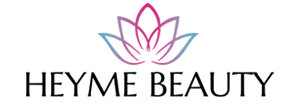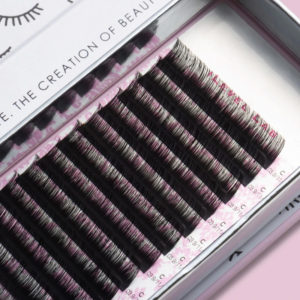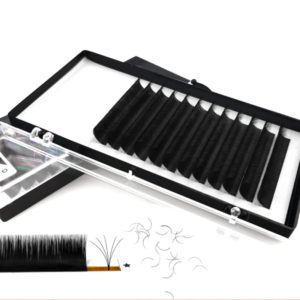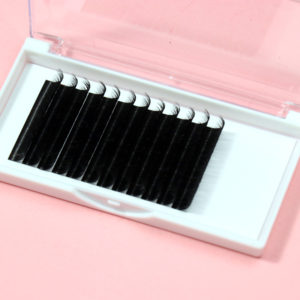![]()
When it comes to eyelash extension rates, most people only see the final number on a salon’s service menu or on a supplier’s price list. What often goes unnoticed is the true value behind that price. From years of direct experience as a manufacturer, I can tell you that these rates are not pulled out of thin air—they represent materials, artistry, safety, and long-term wearability.
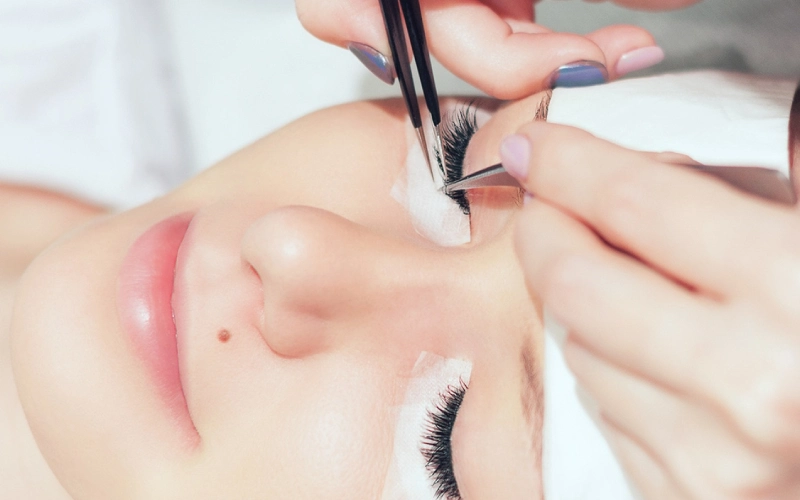
Think about it this way: if you buy a fast-fashion dress for $20, you know it won’t last beyond a season. But if you invest in a high-quality garment, you’re paying for craftsmanship, quality fabrics, and durability. The same applies to eyelash extensions. Cheaper doesn’t always mean better—it usually means compromises on either material safety, adhesive quality, or the lash artist’s skill.
A major factor is the materials used. Extensions can be mink, silk, or synthetic, and each type carries different production and sourcing costs. Then there’s the application technique—classic, volume, or mega volume. A lash artist who has spent hundreds of hours in training and certification will naturally charge more than someone new to the field.
For manufacturers like us, there’s also the responsibility of ensuring international compliance with cosmetic safety standards. From ISO certifications to FDA and EU cosmetic guidelines, we have to guarantee that every lash product is safe for use near the eye—a highly sensitive area. This behind-the-scenes investment directly influences the rates salons and end customers see.
So, when you look at eyelash extension rates, remember: you’re not just paying for lashes. You’re paying for peace of mind, professional artistry, and lasting beauty.
Materials Matter: Mink, Silk, and Synthetic
One of the biggest cost drivers in eyelash extension rates is the material itself. Clients often ask, “Are mink lashes better than synthetic ones?” The truth is, each material has its own strengths—and price tag.
- Mink lashes are often considered the luxury option. Lightweight, fluffy, and soft, they create a natural look that clients love. However, authentic mink is expensive and raises ethical concerns. Many salons now use “faux mink” (high-quality synthetic fibers that mimic mink) to deliver the same luxurious feel at a lower price.
- Silk lashes fall in the mid-range. They’re shinier and slightly heavier, making them a great choice for clients who want a bolder, more defined look without going over the top.
- Synthetic lashes are usually the most affordable. They’re durable and hold their curl well, but they can sometimes look less natural if not applied skillfully.
From a manufacturer’s standpoint, material choice is critical. Producing consistent curl, thickness, and length requires specialized machinery and meticulous quality control. A poorly made synthetic lash may split, bend, or irritate the eyes. That’s why salons willing to invest in premium materials charge higher rates—they’re passing along the assurance of safety and superior wear.
Clients may not realize that a $30 difference in service cost often reflects hundreds of dollars in quality control measures. As manufacturers, we’ve seen firsthand how investing in the right raw materials pays off in client satisfaction and salon reputation.
Craftsmanship and Application Techniques
While materials matter, the lash artist’s craftsmanship plays an equally important role in determining rates. Extensions are applied one by one, using precision tweezers and professional adhesives. This is not a job that can be rushed or improvised.
There are several techniques, each influencing the final rate:
- Classic extensions (1:1 application) are usually the most affordable, as they require fewer lashes and less time.
- Volume extensions (2D–6D fans) demand higher skill and double the number of lashes. Naturally, the price is higher.
- Hybrid extensions combine both styles, appealing to clients who want fullness without the drama of mega volume.
- Mega volume (up to 15D) is the most advanced. Creating and applying ultra-fine fans takes hours, so salons price these services at the top tier.
Training and certification also come at a cost. A lash artist who has invested in advanced workshops, product knowledge, and safety certifications is justified in charging higher rates. The customer isn’t just paying for the service—they’re paying for years of practice and expertise.
From the perspective of manufacturers like us, we often collaborate with educators and industry experts to ensure that our products complement professional training standards. After all, even the best lashes in the world need skilled hands to achieve breathtaking results.
Factors That Influence Eyelash Extension Rates
The final rate a client pays depends on multiple intertwined factors. Let’s break them down:
- Regional Pricing Differences – A set of extensions in New York City can easily cost twice as much as in a small town. Rent, labor costs, and local demand all play a role. In Asia, for example, services are often more affordable due to lower overheads, while European salons may charge premium rates tied to brand reputation.
- Salon Reputation and Artist Experience – A lash artist with five-star reviews, awards, or celebrity clientele can command higher fees. Clients are willing to pay more for guaranteed results.
- Wholesale vs. Retail Pricing Models – Salons that buy lashes wholesale directly from manufacturers often manage better profit margins, allowing them to keep services affordable without cutting corners. Those who rely on smaller distributors often face higher costs, which get passed to clients.
At the end of the day, the factors influencing eyelash extension rates are a blend of artistry, economics, and consumer trust.
Eyelash Extension Rates by Type
Different types of extensions come with different price ranges. Here’s a general breakdown based on salon pricing trends worldwide:
- Classic Extensions: $80–$150 per set
- Volume Extensions: $120–$250 per set
- Hybrid Extensions: $150–$280 per set
- Mega Volume Extensions: $200–$400 per set
Recommended products
-
Camilla Lashes | Lash Extensions
-
Easy Fan Lashes | Lash Extensions
-
Individual Lashes Natural Lash Extensions
-
Non Sensitive Lash Extension Shampoo
For touch-ups (refills), prices usually range between 40–60% of the initial cost, depending on how much work is needed.
As manufacturers, we see how these differences reflect both product costs and labor intensity. Classic sets require fewer lashes and less adhesive, while mega volume sets demand ultra-thin lashes in massive quantities. That’s why salons adjust their rates accordingly.
Why Rates Vary Between Salons and Manufacturers
One of the most common questions we hear is: “Why is there such a big gap between wholesale prices and salon service rates?”
Here’s the truth:
- Labor costs – Applying a full set can take two to four hours. That’s a significant labor investment for the lash artist.
- Training and certification – Professional education doesn’t come cheap. Certified artists often charge more, as they’ve proven their skill under strict guidelines.
- Premium adhesives and tools – Safe, medical-grade adhesives cost more than generic ones. Salons that prioritize safety invest heavily here.
- Overheads – Salons must cover rent, utilities, marketing, and staff wages. This all adds up.
As manufacturers, we supply lashes at bulk rates that can be as low as a few cents per lash. But by the time you factor in the professional service, application time, and aftercare, the final salon rate makes perfect sense.
Wholesale Eyelash Extension Rates: Insights from a Manufacturer
For salon owners, buying lashes wholesale directly from manufacturers like us is a game changer. Wholesale rates can be 60–70% lower than retail. This allows salons to maintain healthy profit margins while offering competitive service rates to clients.
- Bulk Pricing and MOQ (Minimum Order Quantity): Most manufacturers, including us, offer tiered discounts. The more you order, the lower the per-unit cost.
- Custom Branding: Many salons want private-label lashes with their own logo. While this adds slightly to the cost, it elevates their brand identity and justifies premium service rates.
- Long-Term Partnerships: Reliable suppliers provide consistent quality, ensuring salons can keep clients happy without unexpected product failures.
This is why eyelash extension rates are not only about what the client sees at the salon but also about the behind-the-scenes partnerships between salons and manufacturers.
Industry Standards and Regulations That Impact Rates
The eyelash extension industry is highly regulated. Products that touch the eye area must meet strict safety standards. As manufacturers, we must comply with:
- ISO Standards: Ensuring consistency, safety, and quality management across production.
- FDA Guidelines (USA): Adhesives and cosmetic products must pass safety tests for skin and eye use.
- EU Cosmetic Regulations: Require safety assessments and ingredient transparency.
- Ethical Sourcing: More clients demand cruelty-free and vegan lash products, which sometimes cost more to produce.
These regulatory demands influence both wholesale and retail pricing. Salons that choose manufacturers who comply with these standards may charge more, but they also deliver trust and safety—priceless in this industry.
Case Studies: How Rates Reflect Quality
Let’s look at some real-world examples:
- Low-Cost Extensions: A salon in Southeast Asia offered extensions for $30. While the price attracted many customers, complaints soon followed—lashes fell out within days, adhesives caused irritation, and repeat clients dropped.
- Premium Extensions: A luxury salon in Paris charged $280 per set. Clients reported long-lasting results (up to 6 weeks), zero irritation, and a natural, glamorous look. The salon maintained a waiting list despite high rates.
Feedback from lash artists consistently highlights that cheap lashes cost more in the long run. Poor-quality materials damage client trust, while premium lashes create loyal customers who come back every 4–6 weeks.
How Salons Set Their Eyelash Extension Rates
Salons set their pricing based on a combination of product costs, labor, and brand positioning. Common strategies include:
- Profit Margins: Salons usually aim for 300–400% markup on product costs to cover labor and overheads.
- Service Packages: Some salons bundle extensions with aftercare kits or offer memberships.
- Promotions and Loyalty Programs: Discounts for refills or package deals keep clients returning regularly.
By buying directly from manufacturers, salons can reduce costs without reducing quality, creating a win-win for both businesses and clients.
Comparing International Eyelash Extension Rates
Eyelash extension rates vary dramatically worldwide:
- North America: $120–$300 per set. High demand, strong regulation, and brand positioning drive up costs.
- Europe: $100–$280 per set. Luxury markets like Paris and London lead in premium pricing.
- Asia: $50–$150 per set. Rates are lower, but the market volume is much higher.
This global comparison shows how eyelash extensions have become both a luxury service and a mass-market beauty trend, depending on location.
Expert Tips on Getting the Best Value for Eyelash Extensions
For clients:
- Always ask about the materials used.
- Check if the lash artist is certified.
- Be wary of prices that seem “too good to be true.”
For salon owners:
- Partner directly with reliable manufacturers.
- Focus on long-term quality rather than short-term savings.
- Use loyalty programs to keep customers returning.
In short, the best value is found where quality meets transparency.
Future Trends in Eyelash Extension Rates
Looking ahead, several trends will shape pricing in the lash industry:
- Sustainability: Clients increasingly demand eco-friendly, cruelty-free lashes, which may cost more.
- Technology: Automation in lash manufacturing could lower wholesale costs.
- Customization: Personalized lash designs will justify higher rates in premium markets.
As manufacturers, we’re already investing in these areas, knowing that future eyelash extension rates will be influenced not only by beauty trends but also by ethics and innovation.
FAQs
Why do eyelash extension rates vary so much?
Rates vary due to materials, artist skill, location, and salon overhead costs. A high-end salon in a big city naturally has higher rent, labor wages, and branding expenses compared to a small-town studio. Additionally, premium adhesives and ethically sourced lash materials add to the cost, while wholesale partnerships can lower overall pricing.
Are expensive extensions always better?
Not always, but higher rates often reflect safer materials and skilled application. Expensive doesn’t automatically mean best, but it usually indicates that the salon invests in certified lash artists, professional-grade adhesives, and premium lashes. Clients paying higher prices often enjoy longer-lasting wear, better comfort, and a safer experience overall.
3. How much do lash refills cost?
Usually 40–60% of the full set price, depending on time and lash condition. If you maintain your lashes properly and book regular refill appointments every 2–3 weeks, the cost tends to be lower. However, waiting too long may require more lash replacements, which drives the price closer to a full set.
4. Do wholesale rates really save money?
Yes, salons that buy wholesale from manufacturers save up to 70% compared to retail. By ordering in bulk, they reduce per-unit costs and increase profit margins. Manufacturers often provide additional benefits such as private labeling, consistent quality, and customized packaging, which helps salons establish their brand identity and attract repeat clients.
5. Are lash extensions regulated?
Yes. Adhesives and lash products must comply with ISO, FDA, and EU cosmetic safety standards. This ensures they’re safe for use around the delicate eye area. Reputable manufacturers go through strict testing and documentation to meet these requirements, which adds to production costs but guarantees safety for both clients and professionals.
6. What’s the future of eyelash extension pricing?
Expect more sustainable and customizable products that may increase service rates but deliver higher value. As eco-friendly, vegan, and cruelty-free lashes become the norm, production costs may rise slightly. At the same time, new technology in lash manufacturing and advanced adhesives could reduce long-term expenses, creating a balance between affordability and premium results.
Conclusion
At the end of the day, eyelash extension rates reflect much more than just the cost of lashes. They represent materials, artistry, compliance, safety, and trust. As a manufacturer, we’ve seen firsthand how investing in quality leads to long-term client loyalty and industry growth.
Whether you’re a salon owner, lash artist, or client, the key is to understand that value lies not in the cheapest price, but in the safest, most reliable, and most beautiful results. Transparent pricing builds trust, and in the beauty industry, trust is everything.
